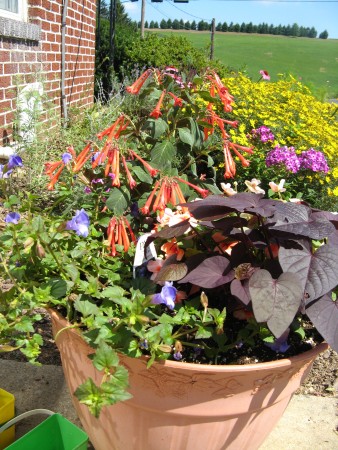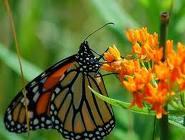Some friends and I had the opportunity to visit several garden centers just outside of Philadelphia last week. I always like to do some greenhouse reconnaissance, or as my husband says, just plain snooping. I was happy to see several cars at all three places, and a mixture of beautiful blooming perennials, and large, well-shaped shrubs. The only thing I was disappointed in was the annuals. Planters and hanging baskets that should have been full of flowers and bright green leaves were straggly, yellow and in need of deadheading.
It’s a common problem, hanging baskets planted in March for Mother’s Day sales look a little sad three months later. Take a look at your deck, porch or patio. How are your baskets and containers faring?
A few simple steps can take your tired, straggly plants and give them new life for the rest of the season.
1. Evaluate the plant varieties. Early season annuals like pansies, nemesia, lobelia, and the like are beautiful in the cooler temps of April and May but get pretty stressed in the heat of July. Remove these cool-season annuals and transplant them to a shady flower bed. They should recover in the fall and bloom again once the mercury comes back down.
2. Fill in the holes with more heat-tolerant flowers like lantana, pentas, zinnias, verbena, calibrachoas, petunias, vinca, or for shady spots: impatiens, begonias, or torenia also know as wishbone flower.
3. Are you feeding enough? I don’t recommend fertilizing plants in the ground, with the possible exception of the vegetable garden. However, plants in a container without access to the complex soil network of organic matter and active organisms that release nutrients into the soil need a little supplementation. Whether you chose the yellow-and-green box or any other balanced fertilizer, a liquid feeding program at every watering or at least three times a week should rejuvenate yellow leaves and give blooms a boost.
*A word about fertilizer: The three numbers on the box such as 15-5-15 or 24-8-16 refer to the ratio of N (nitrogen), P (phosphorus) and K(potassium). This is a generalization, but nitrogen promotes leaf growth and will keep leaves looking green, the phosphorus promotes general cell growth and the potassium component promotes flower color and size. Some fertilizers add other minerals such as iron, magnesium or calcium. Some plants like petunias and calibrachoas like a little extra iron. Others, like geraniums don’t. Just as you read a cereal box to know what you are feeding your kids, read the fertilizer box to know what you are feeding your plants.
*One more tip- a drop of dish-soap in a gallon of water will help the soil absorb water.
4. This step is probably the easiest and the most effective. Are you ready? Give it a haircut. Cutting back overgrown plants by half will bring the container back into balance, promote branching, so straggly plants grow back fuller, and will stimulate flowering for those trailers that are only blooming on the tips. With our hanging baskets, a radical trimming to the edge of the container will take about 2 weeks to grow back in, but will drastically improve the appearance for the rest of the season.
5.Deadheading spent blooms periodically will also promote heavier flowering and clean up the appearance of baskets. This is especially true for larger flowering plants like geraniums, verbena, and some petunias. Often smaller flowers are self-cleaning, or shed their petals, but still benefit from a light shearing periodically.
My last piece of advice is to watch the water. A woman remarked to me several weeks ago that her hanging baskets always died by late June. As an afterthought, she added that it might have helped to water them. Put your finger in the soil, if it feels moist, leave it alone. If it’s dry, water. As plants get larger, and are in full sun, they need more frequent watering. Plants that you have trimmed, baskets in shaded areas, or ferns, let dry out more before irrigating.
On that note, I think I’ll heed my own advice and go rip out the pansies in front of my kitchen door.

 Last summer, after eating his fill of the wild milkweed that permeates the flower beds below the store, a fat monarch caterpillar made his way in the door and spun his chrysalis on one of the chairs. 5-yr old Liam and I had a blast watching it hatch one warm day. What a great experience to share.
Last summer, after eating his fill of the wild milkweed that permeates the flower beds below the store, a fat monarch caterpillar made his way in the door and spun his chrysalis on one of the chairs. 5-yr old Liam and I had a blast watching it hatch one warm day. What a great experience to share.